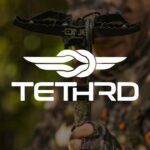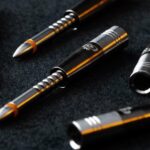CHOOSING AN ARCHERY RIG THAT MATCHES YOUR FRAME IS THE KEY TO ACCURACY- BY RALPH CARLSON
He was the biggest whitetail buck I’d ever seen while hunting, and I just knew I wasn’t going to shoot him.
I was 18 feet up a triple oak and had perfect cover. The wind was in my favor, and I hadn’t made a sound. but the buck was acting goofy; He’d been walking like a dream down a slim trail only 15 steps from my stand tree, and as soon as he put his head behind a big elm tree I was going to draw. Then, for no reason i could detect, the monster 10-point slammed to a stop. His eyes scanned the cover ahead, then to each side. He licked his nose repeat- edly. And then he just waited.
I’ve been around big deer enough to know that, added together, these signals all meant bad news. I kept my gaze off the buck, knowing that a predatory stare might be all it took to unnerve him. It wasn’t enough. When I saw the buck take one tentative step backward, I knew he was going to be out of my life in seconds. If he retreated on the same path that led him to me, i’d have no chance for a shot.
That’s when I caught a monster break. Instead of doing a simple turn-around, the buck chose another escape route; one that i’d brushed a shot to on the other side of my stand tree.
He did me another favor when he decided to slink — rather than blow — out of there. As soon as the buck started moving, I drew my bow and spun slowly on my stand. I was waiting at full draw when the buck’s shoulder hit a small opening.
My arrow buried behind the trophy whitetail’s shoulder, and in seconds i heard a solid crash 50 yards away.
I’ll never forget that deer, not only because he remains among the largest bucks i’ve tagged, but also because I count that shot among the best i’ve ever made. And i’m convinced i’d have never been able to send that arrow on its way had my bow not fit me like a glove.
Naturally, i’d shot a lot of arrows to prepare for that hunt, but this wasn’t flinging shafts in the backyard with perfect form. This was a hurried shot from a contorted position; one that i’d have passed up unless everything felt perfect.
But because the bow fit me so well, I was able to pull it off. And these many seasons later, I still recall that moment as one of the rare times when everything came together like it should. I have bow fit to thank for making it happen.
The Importance of Fit
People look for many qualities when they select a hunting bow. Some of these traits — like silence and a smooth draw — are vitally important to most hunters, as well as being fairly easy to judge. But others are highly subjective.
Factors like speed, draw cycle, weight, length and let-off are highly variable. In other words, what works for one hunter might not for another.
Combining the right qualities into one bow that works for you — and no one else — constitute bow fit, and i’d argue that choosing a bow that fits you well is one of the most important decisions for hunting success.
Let’s look at some of the factors that influence how well a bow fits an individual shooter and how you can examine those qualities to pick the right hunting bow.
Draw Length
Choosing a bow with the proper draw length is so important, i’d argue that it’s one of the building blocks to choosing the right bow. It’s also one of the easiest qualities to get wrong.
My cousin, a successful 3-D shooter, recently attended a clinic conducted by one of the country’s top archery coaches. To start the first session, the coach had all 30 students step up to a shooting line and draw their bows. Then the coach walked down the line and inspected each shooter’s anchor point.
When he’d reached the end of the line, everyone was told to relax their draw.
“Of the 30 guys on this line, i can spot six who have a bow with the right draw length,” the coach said. “the rest of you are too long.”
My cousin was among the latter group.
For some reason — perhaps a desire to bump up arrow speed — most people tend to overestimate their draw length. Unfortunately, being “over-drawn” can have negative effects on shooting form and, therefore, accuracy.
Fortunately, there’s a formula for determining your proper draw length. stand with your back against a wall, with your arms extended straight out, parallel to the floor. Have someone measure the distance between the tips of your middle fingers. Take this number, subtract 15, and divide by two. This is usually an accurate measure of your draw length.
As with much in life, of course, this formula is not perfect. But it will get you in the ballpark. It’s important to note that almost all bows measure draw lengths in 1-inch increments, and many of us (me included) have an ideal draw length that falls somewhere in between two even numbers. In situations like this, most shooters would do well to cheat to the shorter measurement.
Draw Weight
Machismo affects all sports dominated by men, and archery is no different. Most men opt for pulling as much weight as they can thinking the bigger number says something about their manliness. Speed freaks also try to handle larger draw weights in an attempt to squeeze as many feet-per- second as possible out of their bows. There is nothing inherently wrong with this, of course. Speed certainly has benefits and many guys I know can pull far more weight than I can and not lose control or accuracy.
That said, today’s bows perform so much better than even their recent ancestors that draw weight is less an issue than ever before.
Equipped with the right arrow/ broadhead combination, a bow pulling 40 pounds will handle any deer-sized game, and a 50-pound bow is enough for most any critter in North America.
Happily, i’ve noticed an increasing number of skilled bow-hunters who are less concerned with achieving high draw weights and more tuned into finding the right balance between acceptable speed and what they can handle effortlessly under field conditions. Remember, its one thing to pull 70 pounds in your backyard during the summer months; it’s quite another to do the same thing on a frigid November morning when you’re dressed in multiple layers and your muscles are stiff.
One standard draw weight test is as reliable as it is simple: You should be able to hold your bow out in front of you and make a straight-back draw (no dipping or raising the bow arm) every time, regardless of clothing or conditions. If you can’t, you need to crank the draw weight down.
Bow Size
The physical weight of a bow is another aspect of bow fit that can cause some discussion, even among veterans. One of my best friends is a bow-hunter who is as adept at tagging deer as he is shooting a 3-D course. He loves a bow that is light — almost recurve-like — in the hand. However, many top shooters — especially competitive tournament archers — prefer a heavy bow, and their setups are veritable bricks compared to most hunting setups. I enjoy shooting a bow somewhere between those extremes. Hunting practice tips Custom Engraving Personalize your bow by having your name, favorite prey, or archery club engraved on your grip. Visit your Authorized Mathews Retailer for all the engraving options.
How to choose? Much depends on how you’ll use the bow. If you’re a western bow-hunter who hikes the moun- tains for elk or stalks muleys on the plains, shaving ounces makes sense. But if you’re a tree stand whitetailer, the physical weight of a bow is far less of a concern. You’ll be hanging your setup (or cradling it in your lap) for the majority of your hunt.
But there are other factors. For example, the bow may feel acceptably heavy to you pre-rigged, but what about after you’ve added a sight, rest, stabilizer and a quiver full of arrows? all are things to consider when judging how a bow feels in your hand.
Other Considerations
There are other features that can affect bow fit. The grip can make a huge difference; not only as you hold the bow, but as you draw and shoot.
Many archers prefer the comfortable wooden grips featured on most Mathews risers; not only are they easily held, but they remain warmer on cold- weather hunts. Warmth is something that doesn’t seem important until you’ve grabbed a metal riser on a frigid late-season hunt. Grips can also affect accuracy. Most competitive shooters opt for a thin, barely-there grip, which reduces bow torque at the shot. Mathews shooters have the option of switching between the traditional wooden grip and the slimmer “Focus” grip that blends hunting accuracy with the performance of a competition grip.
Thankfully, most reputable pro shops will let you shoot a bow that features each type of grip so you can make the decision that’s right for you.
Brace height (defined as the distance between the string and the deepest part of grip) is another factor to consider when judging fit. The majority of bows will feature a brace height close to 7 inches. generally, brace heights shorter than this measurement result in a faster arrow which, as mentioned, is preferred by some shooters. However, higher brace heights at or above the 7-inch mark tend to be more forgiving and are the best fit for most of us, especially youngsters and beginning hunters.
Finally, there is the physical length (or axle-to-axle measurement) of the bow. The general trend in compounds lately has been toward shorter bows, and many bow-hunters prefer them. Not long ago, shorter bows were considered less accurate and/or forgiving. But with the advent of parallel limb design (an achievement led by Mathews) this notion has largely been thrown to the wayside.
A shorter bow can be easier to maneuver in the steep shooting angles encounter from elevated platforms. i have also found short bows truly shine when i’m hunting from a ground blind. For these reasons, the trend toward shorter bows has been a positive one.
A Personal Exploration
Unfortunately, there is no magic formula for finding the bow that fits.
Bow fit is perhaps the most highly individual aspect of archery, something I realized when I compare myself to other archers with very similar body type and hunting experience.
One of my hunting buddies, who for all practical purposes seems just like me, might have vastly different preferences in the qualities we look for in a hunting bow. Fortunately, with companies like Mathews offering a diverse lineup to choose from, finding a bow that fits you is easier than ever before.
Any time I encounter a new bow- hunter looking for the perfect bow my advice is simple; visit a reputable pro shop where they’ll let you shoot as many bows as you want. Then, judge each bow against the basic qualities listed above.
The one you choose will have the perfect combination that suits you and you alone. Ralph Carlson is an experienced archer from Minnesota. He shoots a Z7 Xtreme because the compact design fits his frame and hunting style.






